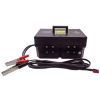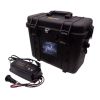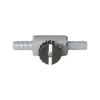Proactive Storm 50 12V Plastic Pump
Features
- Can operate under harsh conditions with higher turbidity
- Sleek outside minimizes well hang-ups
- Can run continuously in water without the need for a cool down
- Free ground shipping
- Expedited repair and warranty service
- Lifetime technical support
- More
Overview
The Proactive Storm 50 pump is capable of pumping up to 50 feet from ground level (DTW) by simply connecting to a 12-volt deep-cycle battery. Its reliable design is perfect for continuous sampling and purging of groundwater wells and low-flow sampling.
Mechanics
The Storm 50 is ideal for low-flow sampling in conjunction with the Low Flow Sampling Controller. Low flow sample all the way down to 40mL per minute. To achieve even a lower flow, simply add the Low Flow Sampling Control Valve in conjunction with the Low Flow Sampling controller to achieve flow rates of 1 mL per minute or less.
Note: All pumps from Proactive are manufactured from PFOA-Free Parts (Except Abyss Pump Line).
- Power Consumption: 60 Watts (max)
- Volt Recommendation: 12-15V at source
- Maximum Amp Output: 4 Amp
- Measurements: 24" length x 0.90" diameter
- Use With: Optional Low Flow Sampling Controller
- Required Tubing: 1/4" or 3/8" ID tubing
- (1) 12V Engineered Plastic Storm 50 pump with 60' wire lead
- (1) Set of 12V battery clamps
In The News
Reimagining Water Filtration: How Monitoring and Science Enhance FloWater Filtration Systems
Over 50% of Americans think their tap water is unsafe , according to the Environmental Working Group (EWG). Other recent surveys have found that number to be as high as 70% of persons surveyed. Whether due to increased public awareness of water quality issues or confusion about how municipal water sources are regulated, there is a clear distrust of tap water in the United States. According to industry expert Rich Razgaitis, CEO and co-founder of the water purification company FloWater, this issue creates a damaging cycle. Razgaitis explained that the health and environmental problems associated with contaminated water aren’t the only issues. As people become increasingly aware that some tap water is unsafe, they resort to bottled water.
Read MoreMonitoring New Hampshire’s Aquatic Ecosystems: Continuous Data Collection in the Lamprey River Watershed
New Hampshire’s aquatic ecosystems provide a range of ecosystem services to the state and region. Resources and services like clean water, carbon storage, climate regulation, nutrient regulation, and opportunities for recreation all depend on New Hampshire’s aquatic ecosystems remaining healthy. Jody Potter, an analytical instrumentation scientist at the University of New Hampshire (UNH), is studying these aquatic ecosystems in hopes of developing an improved understanding of ecosystem services and their interactions with climate change, climate variability, and land use changes. [caption id="attachment_39799" align="alignnone" width="940"] Aquatic sensors in the Merrimack River in Bedford, NH, with I-293 in the background.
Read MoreFrom Hurricanes to Florida’s Red Tides: Monitoring the Southwest Gulf Coast
Nearly every year, southwest Florida is blighted by harmful Karenia brevis blooms–known colloquially as Florida red tides. These harmful algal blooms (HABs) form over the West Florida shelf and are pushed shorewards by winds and currents. Once in touching distance of the coast, they often intensify, fed by land-based runoff, anthropogenic nutrients, and decomposing marine life killed by toxins produced by these red tides. Red tides have become more severe and persistent over the past 20 years, causing major environmental and economic damage.
Read More














